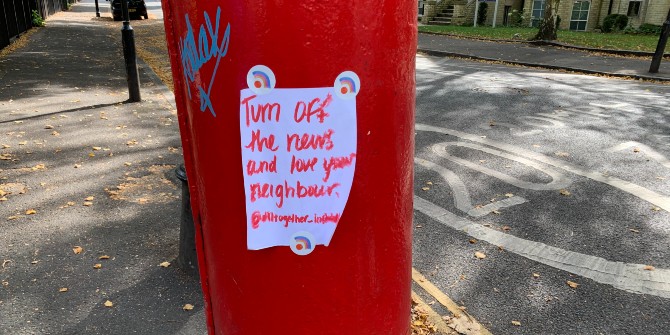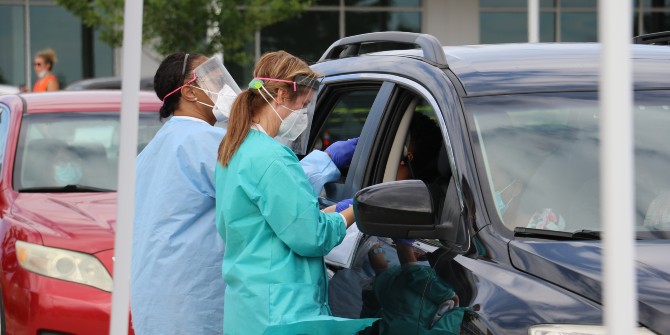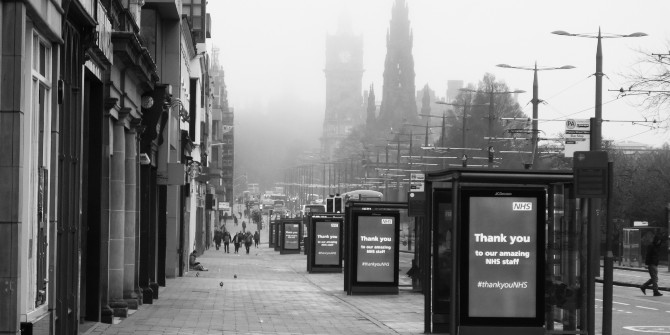Behavioural science has sometimes seemed to be an afterthought for policymakers during the pandemic. Celia Blanco-Jimenez (LSE) rewatches two LSE events in May and November and looks at how our thinking has evolved.
How have 10 months of living in a COVID world shaped behavioural scientists’ thinking, and how has it evolved? To get a sense of how perspectives have evolved, I revisited two public discussions on behavioural science and COVID hosted by the LSE. The first was in May, with Nick Chater, Liam Delaney, Paul Dolan, Ulrike Hahn and Grace Lordan. The second took place in November, this time with Nick Chater, Paul Dolan, Grace Lordan, Tali Sharot and Rory Sutherland.
The need for multi-disciplinarity and diversity in the decision-making process
One of the main concerns in both events was the need for multi-disciplinarity in the decision process. This is not just a health, but also an economic and social pandemic, in which all sciences, including social sciences, should have a voice. While economics seems to have increased its weight in the conversation, the social side has been almost entirely disregarded. We have not become better at including all sciences and breaking down disciplinary barriers, or at least not yet.

Another concern that has become apparent during the last six months is the need for diversity and inclusion: we need to consult those who know something about those whose lives are affected when taking radical policy decisions. The focus of the conversation seems to have veered from compliance to social issues raised by lockdowns, as we become more aware of them. The response to the “Protect the NHS” message led to people avoiding treatment, and ultimately cost lives. Indeed, some studies suggest deaths from cancer misdiagnoses will surpass those from COVID.
The lack of inclusivity is also revealed in the demographics of the decision-makers, who are mostly middle-aged men in their 50s, highly paid and able to work from home. These people who are not most affected by the measures, and are at an age when existential dread is at its highest.
Increasing worries about social impacts
Over time, we have witnessed some of the social impacts of lockdowns. While the prospect of children falling behind in school was raised back in May, we now have data revealing that some disappeared altogether from the school system after schools were closed. “Stay at home” is a good message if you have a warm, cosy home, but this is not the reality for everyone.
Mental health was repeatedly raised in these conversations. Concerns were raised in May, but we now have data. The good news is that people seemed to go back to initial levels of wellbeing after a month of lockdown in the US. But while we know that adaptation is generally strong for both good and bad shocks, there is no adaptation when it comes to mental health – one does not ‘get used’ to being depressed. People with pre-existing mental health issues will struggle to adapt to the new reality, and will be most affected by the measures. Policy measures should reflect this.
Permanent or transitory changes?
Which things will go back to normal, and which are changed forever? This is a recurrent conversation, and it seems likely that changes already in progress have accelerated. An increase in working from home, and a reduction in unnecessary travel will probably persist, as well as events like conferences being held online. Another concern was whether online university learning would become the norm, in which case we could see a winner takes-it-all scenario. Nonetheless, things do tend to revert to normal; the recovery of confidence in air travel after 9/11 is an example.
The changing role of behavioural science
Discussion about the role of behavioural science in pandemic policy has also changed. In May, the focus was on trust and compliance, and how it could help with scenario planning, as well as the new concept of “behavioural fatigue”. Experts soon discredited this concept: most of us brush our teeth every day without growing tired of it and eventually stopping, and there is no reason to think norm compliance will be different. Behavioural science seems to have become the “science of compliance and hand washing”, instead of contributing to issues such as dealing with loneliness and isolation, or how to ameliorate the negative social impacts from the measures.
What about welfare?
The question of whether we should – or are able to – include welfare analysis is still up for discussion. Some experts are of the opinion that it is not possible in such complex circumstances, where the government is acting on the basis of disaster avoidance rather than cost-benefit analysis. Others claim that some sort of welfare analysis is necessary in order to prevent people “falling through the cracks”. The persistent focus on lives vs livelihoods is problematic in this respect, as health and economics are not the only factors. Dimensions such as abuse, mental health, children out of school, the long term effects of unemployment, and missed appointments that lead to cancer misdiagnoses need to be accounted for when considering the mortality figures. Only then can we have a conversation about trade-offs, and ultimately it may not be about lives vs livelihoods, but about lives vs lives.
Most agreed that the government has become more sensitive to social issues. For example, schools were not closed during the second UK lockdown. Nonetheless, we still badly need diversity and inclusion in the decision-making process, especially in order to ensure social impacts get a voice.
This post represents the views of the author and not those of the COVID-19 blog, nor LSE.





